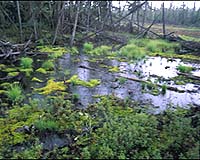 |
San Diego CA (SPX) Mar 18, 2011 Bursts of intense global warming that have lasted tens of thousands of years have taken place more frequently throughout history than previously believe, according to evidence gathered by a team led by Scripps Institution of Oceanography, UC San Diego researchers. Richard Norris, a professor of geology at Scripps who co-authored the report, said that releases of carbon dioxide sequestered in the deep oceans were the most likely trigger of these ancient "hyperthermal" events. Most of the events raised average global temperatures between 2 degrees and 3 degrees Celsius (3.6 and 5.4 degrees F), an amount comparable to current conservative estimates of how much temperatures are expected to rise in coming decades as a consequence of anthropogenic global warming. Most hyperthermals lasted about 40,000 years before temperatures returned to normal. The study appears in the March 17 issue of the journal Nature. "These hyperthermals seem not to have been rare events," Norris said, "hence there are lots of ancient examples of global warming on a scale broadly like the expected future warming. We can use these events to examine the impact of global change on marine ecosystems, climate and ocean circulation." The hyperthermals took place roughly every 400,000 years during a warm period of Earth history that prevailed some 50 million years ago. The strongest of them coincided with an event known as the Paleocene-Eocene Thermal Maximum, the transition between two geologic epochs in which global temperatures rose between 4 degrees and 7 degrees C (7.2 degrees and 12.6 degrees F) and needed 200,000 years to return to historical norms. The events stopped taking place around 40 million years ago, when the planet entered a cooling phase. No warming events of the magnitude of these hyperthermals have been detected in the geological record since then. Phil Sexton, a former student of Norris' now at the Open University in the United Kingdom, led the analysis of sediment cores collected off the South American coast. In the cores, evidence of the warm periods presented itself in bands of gray sediment layered within otherwise pale greenish mud. The gray sediment contained increased amounts of clay left after the calcareous shells of microscopic organisms were dissolved on the sea floor. These clay-rich intervals are consistent with ocean acidification episodes that would have been triggered by large-scale releases of carbon dioxide. Large influxes of carbon dioxide change the chemistry of seawater by producing greater amounts of carbonic acid in the oceans. The authors concluded that a release of carbon dioxide from the deep oceans was a more likely cause of the hyperthermals than other triggering events that have been hypothesized. The regularity of the hyperthermals and relatively warm ocean temperatures of the period makes them less likely to have been caused by events such as large melt-offs of methane hydrates, terrestrial burning of peat or even proposed cometary impacts. The hyperthermals could have been set in motion by a build-up of carbon dioxide in the deep oceans caused by slowing or stopping of circulation in ocean basins that prevented carbon dioxide release. Norris noted that the hyperthermals provide historical perspective on what Earth will experience as it continues to warm from widespread use of fossil fuels, which has increased carbon dioxide concentrations in the atmosphere nearly 50 percent since the beginning of the Industrial Revolution. Hyperthermals can help scientists produce a range of estimates for how long it will take for temperatures to fully revert to historical norms depending on how much warming human activities cause. "In 100 to 300 years, we could produce a signal on Earth that takes tens of thousands of years to equilibrate, judging from the geologic record," he said. The scientists hope to better understand how fast the conditions that set off hyperthermals developed. Norris said that 50 million year old sediments in the North Sea are finely layered enough for scientists to distinguish decade-to-decade or even year-to-year changes. Co-authors of the paper include researchers from the National Oceanography Centre Southampton at the University of Southampton in England and the Center for Marine Environmental Sciences, University of Bremen, Germany.
Share This Article With Planet Earth
Related Links University of California - San Diego Climate Science News - Modeling, Mitigation Adaptation
 Northern Peatlands A Misunderstood Player In Climate Change
Northern Peatlands A Misunderstood Player In Climate ChangeEdmonton, Canada (SPX) Mar 18, 2011 University of Alberta researchers have determined that the influence of northern peatlands on the prehistorical record of climate change has been over estimated, but the vast northern wetlands must still be watched closely as the planet grapples with its current global warming trend. Northern peatlands, which are a boggy mixture of dead organic material and water, cover more than four mill ... read more |
|
| The content herein, unless otherwise known to be public domain, are Copyright 1995-2010 - SpaceDaily. AFP and UPI Wire Stories are copyright Agence France-Presse and United Press International. ESA Portal Reports are copyright European Space Agency. All NASA sourced material is public domain. Additional copyrights may apply in whole or part to other bona fide parties. Advertising does not imply endorsement,agreement or approval of any opinions, statements or information provided by SpaceDaily on any Web page published or hosted by SpaceDaily. Privacy Statement |